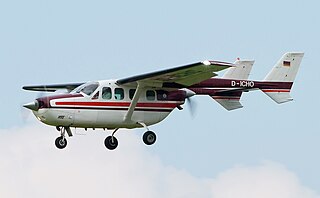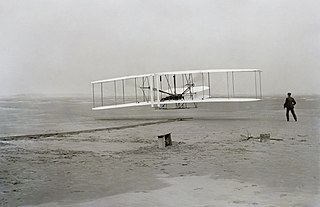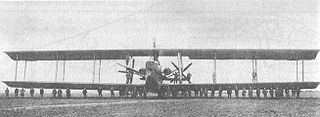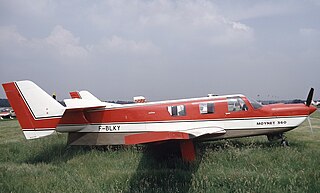
An aircraft constructed with a push-pull configuration has a combination of forward-mounted tractor (pull) propellers, and backward-mounted (pusher) propellers.

An aircraft constructed with a push-pull configuration has a combination of forward-mounted tractor (pull) propellers, and backward-mounted (pusher) propellers.
The earliest known examples of "push-pull" engined-layout aircraft was the Short Tandem Twin.
An early pre-World War I example of a "push-pull" aircraft was the Caproni Ca.1 of 1914 which had two wing-mounted tractor propellers and one centre-mounted pusher propeller. Around 450 of these and their successor, the Ca.3 were built. One of the first to employ two engines on a common axis (tandem push-pull) was the one-off, ill-fated Siemens-Schuckert DDr.I fighter of 1917.
German World War I designs included the only Fokker twin-engined design of the period, the Fokker K.I from 1915; followed by the unusual Siemens-Schuckert DDr.I triplane fighter design of late 1917, and concluding with the laterally-offset "push-pull" Gotha G.VI bomber prototype of 1918.
Claudius Dornier embraced the concept, many of his flying boats using variations of the tandem "push-pull" engine layout, including the 1922 Dornier Wal, the 1938 Dornier Do 26, and the massive 1929 Dornier Do X, which had twelve engines driving six tractors and six pushers. A number of Farmans and Fokkers also had push-pull engine installations, such as the Farman F.121 Jabiru and Fokker F.32.
Push-pull designs have the engines mounted above the wing as Dornier flying boats or more commonly on a shorter fuselage than conventional one, as for Rutan Defiant or Voyager canard designs. Twin boomers such as the Cessna Skymaster and Adam A500 have the aircraft's tail suspended via twin booms behind the pusher propeller. In contrast, both the World War II-era Dornier Do 335 and the early 1960s-designed French Moynet M 360 Jupiter experimental private plane had their pusher propeller behind the tail. [1] [2]
While pure pushers decreased in popularity during the First World War, the push-pull configuration has continued to be used. The advantage it provides is the ability to mount two propellers on the aircraft's centreline, thereby avoiding the increased drag that comes with twin wing-mounted engines. It is also easier to fly if one of the two engines fails, as the thrust provided by the remaining engine stays in the centerline. In contrast, a conventional twin-engine aircraft will yaw in the direction of the failed engine and become uncontrollable below a certain airspeed, known as VMC.
The rear engine operates in the disturbed air from the forward engine, which may reduce its efficiency to 85% of the forward engine. [3] [4] In addition the rear engine can interfere with the aircraft's rotation during takeoff if installed in the tail, or they require additional compromise to be made to ensure clearance. This is why they are more common on seaplanes, where this is not a concern.
Pilots in the United States who obtain a multi-engine rating in an aircraft with this push-pull, or "centerline thrust," configuration are restricted to flying centerline-thrust aircraft; pilots who obtain a multi-engine rating in conventional twin-engine aircraft do not have a similar limitation with regard to centerline-thrust aircraft. The limitation can be removed by further testing in a conventional multi-engine aircraft. [5]

Despite its advantages push-pull configurations are rare in military aircraft. In addition to the problems noted for civil aircraft, the increased risk to the pilot in the case of a crash or the need to parachute from the aircraft also pose problems. During a crash the rear engine may crush the pilot and if bailing out, the pilot is in danger of hitting the propeller. Examples of past military applications include the aforementioned Siemens-Schuckert DDr.I twin-engined triplane and the Gotha G.VI, with its engines mounted on the front and rear ends of two separate fuselages. More successful was the Italian Caproni Ca.3 trimotor, with two tractor engines and one pusher. Between the wars, most push-pull aircraft were flying boats, of which the Dornier Wal was probably the most numerous, while a number of heavy bombers, such as the Farman F.220 used engines mounted in push-pull pairs under the wings. Near the end of World War II, the German Dornier Do 335 push-pull twin-engined, Zerstörer-candidate heavy fighter featured explosive charges to jettison the rear propeller and dorsal tailfin, a manually-jettisonable main canopy, as well as an ejection seat. One of the last military aircraft to use the configuration was the American Cessna O-2, which was used for forward air control during the Vietnam War.

The Dornier Do 335Pfeil (Arrow) is a heavy fighter built by Dornier for Germany during World War II. The Pfeil's performance was predicted to be better than other twin-engine designs due to its unique push-pull configuration and the lower aerodynamic drag of the in-line alignment of the two engines. It was Nazi Germany's fastest piston-engined aircraft of World War II. The Luftwaffe was desperate to get the design into operational use, but delays in engine deliveries meant that only a handful were delivered before the war ended.

The Adam A500 is an American six-seat civil utility aircraft that was produced by Adam Aircraft Industries. The aircraft is of pod-and-boom, push-pull configuration with its two Continental TSIO-550-E piston engines mounted to provide centerline thrust.

The Cessna Skymaster is an American twin-engine civil utility aircraft built in a push-pull configuration. Its engines are mounted in the nose and rear of its pod-style fuselage. Twin booms extend aft of the wings to the vertical stabilizers, with the rear engine between them. The horizontal stabilizer is aft of the pusher propeller, mounted between and connecting the two booms. The combined tractor and pusher engines produce centerline thrust and a unique sound. The Cessna O-2 Skymaster is a military version of the Cessna 337 Super Skymaster.

In aeronautical and naval engineering, pusher configuration is the term used to describe a drivetrain of air- or watercraft with propulsion device(s) after the engine(s). This is in contrast to the more conventional tractor configuration, which places them in front.

In aviation, the term tractor configuration refers to an aircraft constructed in the standard configuration with its engine mounted with the propeller in front of it so that the aircraft is "pulled" through the air. Oppositely, the pusher configuration places the airscrew behind and propels the aircraft forward. Through common usage, the word "propeller" has come to mean any airscrew, whether it actually propels or pulls the plane.

The Scaled Composites ARES is a demonstrator aircraft built by Scaled Composites. ARES is an acronym for Agile Responsive Effective Support.

A twin-boom aircraft has two longitudinal auxiliary booms. These may contain ancillary items such as fuel tanks and/or provide a supporting structure for other items. Typically, twin tailbooms support the tail surfaces, although on some types such as the Rutan Model 72 Grizzly the booms run forward of the wing. The twin-boom configuration is distinct from twin-fuselage designs in that it retains a central fuselage.

The Zeppelin-Staaken R.VI was a four-engined German biplane strategic bomber of World War I, and the only Riesenflugzeug design built in any quantity.

The Dornier Do R Superwal was a German flying boat airliner of the 1920s.

The Siemens-Schuckert R.VIII was a bomber aircraft designed and built in Germany from 1916.
The Boulton & Paul P.12 Bodmin was an experimental British twin-engined biplane bomber with its engines mounted in a fuselage engine room and with tandem pairs of tractor and pusher airscrews mounted between the wings. The two Bodmins built flew in 1924, proving the concept but the layout was not developed to production.

The Fokker D.XXIII was a Dutch single-seat fighter designed and built by Fokker. Only one aircraft was flown before the country was invaded by the Germans in May 1940.

The Moynet M 360 Jupiter was a small executive transport built in France in the 1960s. It had an unusual twin-push-pull, single-fuselage configuration. Two prototypes were produced, the second with more power and seating, but no sales resulted.

The Dornier Do 29 was an experimental aircraft developed by Dornier Flugzeugwerke and the Deutsche Versuchsanstalt für Luftfahrt in the 1950s, used to test a tilting-propeller system for short takeoff and landing (STOL) aircraft. The concept was proved successful in flight testing; however, no further development of the system or aircraft was proceeded with, and at the conclusion of its test program the Do 29 was retired.

The Zeppelin-Lindau Rs.II was a biplane flying boat, designed by Claudius Dornier as a follow-on to his Zeppelin-Lindau Rs.I and built during 1914–1915 on the German side of Lake Constance. Initially this aircraft was powered by three engines mounted inside the hull driving three pusher propellers via gearboxes and shafts. The later version was powered by four engines in two push-pull nacelles mounted between the wings.

The Siemens-Schuckert DDr.I was a World War I German twin engine, push-pull configuration triplane fighter aircraft. Only one was built, crashing on its first flight.

The Velocity V-Twin is an American twin engined, homebuilt aircraft, designed by Velocity Aircraft and following the layout of their earlier Velocity XL but with a single vertical tail. It is the flagship model of the Velocity Aircraft Line.

The Siemens-Schuckert L.I was a large, three-engined biplane bomber aircraft, built in Germany towards the end of World War I. It was a twin boom design, strongly influenced by the successful Caproni Ca.3. Three were built but not used operationally.